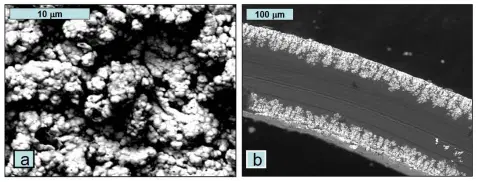A Stronger, Simpler Fuel Cell Membrane Electrode Assembly
Membrane technology first developed to create artificial muscles may soon be used to improve fuel cells. Pictured above is a fuel cell membrane manufactured using this new method. Resulting surface porosity (a) and a deeply diffused conductive area (light lines in b) increase surface area available for electricity production and create a stonger, simpler, long-lasting membrane.
PROBLEM: Manufacturers of low temperature fuel cells need solutions for improving the strength, durability and manufacturability of a key component, the membrane electrode assembly, or MEA.
The MEA consists of a thin polymer membrane embedded with precious metal catalysts that is sandwiched between two carbon support layers and two electrode layers, making five layers in all that must be aligned and assembled by hand using hot pressing techniques.
The membrane is fragile, making it the part of the fuel cell most likely to fail, especially in rugged or high pressure environments. Areas where the MEA is weakened by hot pressing during manufacturing are the most common failure points.
Additionally, the membranes degrade over time, producing less electricity. The degradation is a result of current methods used to embed catalysts onto the membrane.
SOLUTION: The new membrane manufacturing process developed at UMaine produces an MEA that is
- stronger and able to withstand higher pressure because the membrane is thicker and has none of the weak spots usually caused by hot pressing.
- easier to manufacture, by eliminating hot pressing and by reducing the number of hand assembled layers from 5 to 3 . This also reduces registry errors and improves quality control.
- anticipated to be more durable because the manufacturing process embeds the catalyst deep into the membrane rather than spreading it on the membrane surface as is current practice.
HOW IT WORKS:
Other low-temperature fuel cells MEAs use carbon-supported catalyst layers, which can deteriorate over time and cause the catalyst to clump together. The clumped catalysts cause the MEA to produce less electricity. Our method, however, eliminates the two carbon-supported layers by supporting the catalyst directly within the porous outer layers of the membrane. We are able to do this by using a new catalyst application technique. Electroless plating imbeds catalyst material and other metals within the molecular network of the membrane. This improves the distribution and effectiveness of the catalyst, and also improves ionic conduction through the polymer membrane. This technique may also allow a wider range of high-volume manufacturing strategies and improve the durability of the membrane electrode assembly.
STATUS: Our MEA works as a fuel cell. It has tested 500 hours using hydrogen and oxygen fuel at up to 80 degrees C at 3 ATM pressure. We have developed a baseline for further optimization of various manufacturing process to effect durability.
DEVELOPMENT PLAN:
We currently are installing equipment to test the operating temperature and duration under differing circumstances including high atmospheric loads.
The early opportunities for this technology are likely in rugged environments (military and space applications) but we would like industry feedback about what is most important – strength, durability, or manufacturability – so we can structure our development plan and product optimization accordingly.
PATENTS: (WO2010132556) MEMBRANE AND CATALYST COMPOSITE FOR MEMBRANE ELECTRODE ASSEMBLY . This is a nationalized as US Application 13/320,140 filed 01/25/2012. Priority date 5/12/2009.
TECH REF: 2009-11
TEAM
FOR MORE INFO
Kris Burton, Commercialization
LINKS

